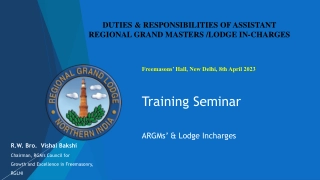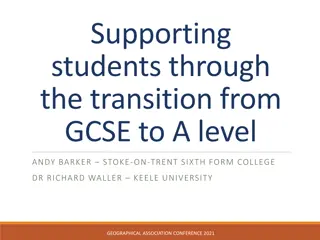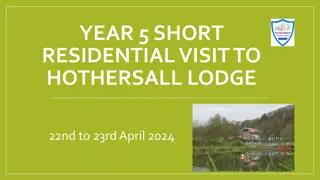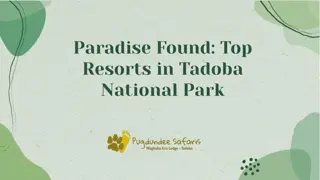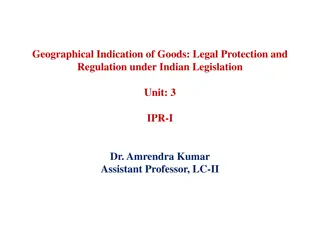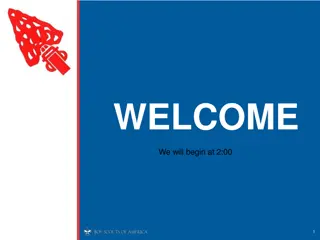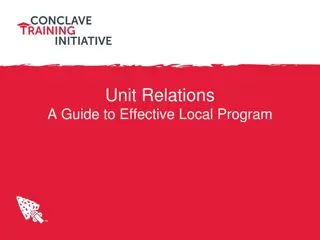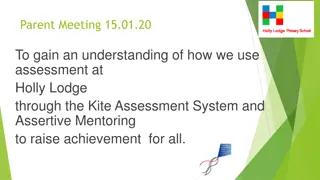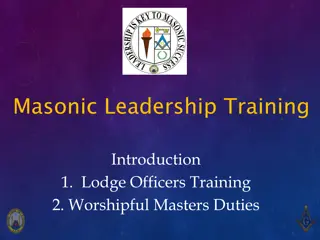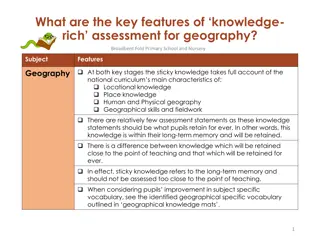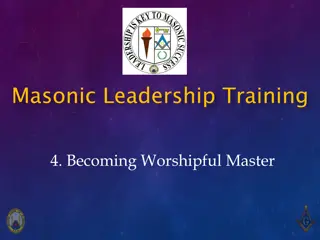Developing Geographical Knowledge and Skills at Ditton Lodge
At Ditton Lodge, the vision is to foster a lifelong love for learning, exemplified through the Geography curriculum. Students are encouraged to observe, appreciate, and understand diverse environments. The curriculum emphasizes the importance of geographical processes, human impact on the planet, and the development of crucial skills such as data analysis and communication. Fieldwork plays a significant role in practical learning, while careful lesson sequences and engaging tasks ensure effective knowledge acquisition. The National Curriculum aims for KS1 students include developing locational knowledge and understanding physical and human geographical features.
Download Presentation

Please find below an Image/Link to download the presentation.
The content on the website is provided AS IS for your information and personal use only. It may not be sold, licensed, or shared on other websites without obtaining consent from the author.If you encounter any issues during the download, it is possible that the publisher has removed the file from their server.
You are allowed to download the files provided on this website for personal or commercial use, subject to the condition that they are used lawfully. All files are the property of their respective owners.
The content on the website is provided AS IS for your information and personal use only. It may not be sold, licensed, or shared on other websites without obtaining consent from the author.
E N D
Presentation Transcript
Geography at Ditton Lodge
Intent Intent At Ditton Lodge, our vision statement is 'Together we succeed as lifelong learners . This is seen in every area of the curriculum including Geography. We know the value of being able to LEARN (Listen, Enjoy & take risks, Aim high & achieve, Respect and Never give up). These school values will be demonstrated by students within each lesson. Our aim is to develop children s interest, knowledge and respect for the diverse places, people and resources around us. This is made possible by a thorough understanding of physical and human processes, and the interaction of the two.
Geography Intent Children at Ditton Lodge are encouraged to observe, appreciate and understand the wonderful diversity around them. They are clearly taught the human and physical processes geographical processes. Together, this appreciation and knowledge leads to a genuine fascination and desire to aim high and achieve. The effects of humans on the planet is something children need to be sensitively made aware of in order for them to make informed decisions as they grow older. Fieldwork is a vital part of putting geographical knowledge into practise, giving children the opportunity to actively observe and take pride in the features of their community. Prior knowledge is built on through a carefully planned sequences of lessons. Tasks are designed for children to learn, explore, then demonstrate the knowledge acquired in each lesson.
Geography Intent As stated in the national curriculum, we aim to ensure that all pupils: develop contextual knowledge of the location of globally significant places both terrestrial and marine including their defining physical and human characteristics and how these provide a geographical context for understanding the actions of processes understand the processes that give rise to key physical and human geographical features of the world, how these are interdependent and how they bring about spatial variation and change over time are competent in the geographical skills needed to: -collect, analyse and communicate with a range of data gathered through experiences of fieldwork that deepen their understanding of geographical processes -interpret a range of sources of geographical information, including maps, diagrams, globes, aerial photographs and Geographical Information Systems -communicate geographical information in a variety of ways, including through maps, numerical and quantitative skills and writing at length.
National Curriculum aims KS1 Intent page 1 of 3 The aims of the Syllabus are that students in KS1 will use: Locational knowledge: name and locate the world s seven continents and five oceans name, locate and identify characteristics of the four countries and capital cities of the United Kingdom and its surrounding seas Place knowledge understand geographical similarities and differences through studying the human and physical geography of a small area of the United Kingdom, and of a small area in a contrasting non-European country continued
National Curriculum aims KS1 Intent page 2 of 3 Human and physical geography identify seasonal and daily weather patterns in the United Kingdom and the location of hot and cold areas of the world in relation to the Equator and the North and South Poles use basic geographical vocabulary to refer to: key physical features, including: beach, cliff, coast, forest, hill, mountain, sea, ocean, river, soil, valley, vegetation, season and weather key human features, including: city, town, village, factory, farm, house, office, port, harbour and shop continued
National Curriculum aims KS1 page 3 of 3 Intent The aims of the Syllabus are that students in KS1: Geographical skills and fieldwork use world maps, atlases and globes to identify the United Kingdom and its countries, as well as the countries, continents and oceans studied at this key stage use simple compass directions (North, South, East and West) and locational and directional language [for example, near and far; left and right], to describe the location of features and routes on a map use aerial photographs and plan perspectives to recognise landmarks and basic human and physical features; devise a simple map; and use and construct basic symbols in a key use simple fieldwork and observational skills to study the geography of their school and its grounds and the key human and physical features of its surrounding environment.
National Curriculum aims KS2 page 1 of 3 Intent The aims of the Syllabus are that students in KS2 can: Locational knowledge locate the world s countries, using maps to focus on Europe (including the location of Russia) and North and South America, concentrating on their environmental regions, key physical and human characteristics, countries, and major cities name and locate counties and cities of the United Kingdom, geographical regions and their identifying human and physical characteristics, key topographical features (including hills, mountains, coasts and rivers), and land-use patterns; and understand how some of these aspects have changed over time identify the position and significance of latitude, longitude, Equator, Northern Hemisphere, Southern Hemisphere, the Tropics of Cancer and Capricorn, Arctic and Antarctic Circle, the Prime/Greenwich Meridian and time zones (including day and night)
National Curriculum aims KS2 page 2 of 3 Intent Place knowledge understand geographical similarities and differences through the study of human and physical geography of a region of the United Kingdom, a region in a European country, and a region within North or South America Human and physical geography describe and understand key aspects of: physical geography, including: climate zones, biomes and vegetation belts, rivers, mountains, volcanoes and earthquakes, and the water cycle human geography, including: types of settlement and land use, economic activity including trade links, and the distribution of natural resources including energy, food, minerals and water
National Curriculum aims KS2 Intent page 3 of 3 Geographical skills and fieldwork use maps, atlases, globes and digital/computer mapping to locate countries and describe features studied use the eight points of a compass, four and six-figure grid references, symbols and key (including the use of Ordnance Survey maps) to build their knowledge of the United Kingdom and the wider world use fieldwork to observe, measure, record and present the human and physical features in the local area using a range of methods, including sketch maps, plans and graphs, and digital technologies.
Cross Curricular Links Intent Geography provides opportunities for pupils to develop the key skills in: English: opportunities for discussion, orally rehearsing responses to the lesson s learning question, and recording knowledge through the use of bullet points, labelling, and longer pieces of writing in different genres. The subject also builds on students vocabulary with key words being learned and used in all lessons. Maths: students will interpret, create and present data, use measurements, frequencies and statistics
Cross Curricular Links Intent History and Science: The sequence of the foundation curriculum is designed so children can build upon learning in a range of disciplines. Year 1, for example, learned about hot and cold climates before moving to the life of a significant individual: the travels around the world of Sir David Attenborough, and then the climate in the UK. Year 6 were able to use their knowledge from the unit studying the Windrush generation to help them comparing North America to the UK.
Cross Curricular Links- continued Intent Computing: Children are encouraged to build on knowledge through using the internet and different programmes selectively. Children apply computing skills to geographical knowledge, for example finding and interpreting weather data and designing an automated weather warning system in year 4. Links to specific websites and reading material are added to Google Classroom for children and their families to access and enjoy at home. Ditton Lodge also subscribes to DigiMaps for children to access, annotate and save high-quality maps from around the world and see how they have changed over time.
Geography Implementation
Geography in EYFS Implementation In Reception there are topics lasting two weeks. Within these, the early years framework is used to encourage children to make observations about their surroundings. Similarities and differences between their lives and those of people around the world are incorporated through stories, pictures and festivals. Teachers in Key Stage 1 draw upon previous coverage of the Early Learning Goals and build on this.
Geography in KS1 Implementation Year 1: Continents, Oceans, UK countries, capitals and seas name and locate the world s seven continents and five oceans name, locate and identify characteristics of the four countries and capital cities of the United Kingdom and its surrounding seas Study hot and cold locations identify seasonal and daily weather patterns in the United Kingdom and the location of hot and cold areas of the world in relation to the Equator and the North and South Poles Revisit Continents, Oceans, UK countries, capitals and seas later in the year
Geography in KS1 Implementation Year 2: Human and physical geography in the local area Recap from Year 1 the United Kingdom and its countries, as well as the terminology and relevance to us of port, harbour, urban, rural, coastal Study human and physical geography of a small area of United Kingdom, and of a contrasting non-European country Understand geographical similarities and differences through studying the human and physical geography of a small area of the United Kingdom, and of a small area in a contrasting non-European country Fieldwork and map skills Use simple fieldwork and observational skills to study the geography of their school and its grounds and the key human and physical features of its surrounding environment.
Geography in LKS2 Implementation Year 3: Countries and regions of the UK Name and locate counties and cities of the United Kingdom, geographical regions and their identifying human and physical characteristics, key topographical features (including hills, mountains, coasts and rivers), and land-use patterns; and understand how some of these aspects have changed over time Fieldwork and map skills Making, reading and using a compass
Geography in LKS2 Year 4: Study Latitude and Longitude Identify the position and significance of latitude, longitude, Equator, Northern Hemisphere, Southern Hemisphere, the Tropics of Cancer and Capricorn, Arctic and Antarctic Circle, the Prime/Greenwich Meridian and time zones (including day and night) Implementation Rivers The study focuses and elaborates the content of Rivers and to support ancient river civilisation explored in the following history learning module. Summer term study that elaborates on Autumn module and connects to the next river civilisation module focusing on the ancient Egyptians The Water Cycle Human and physical geography
Geography in UKS2 Year 5: Implementation Study location of countries of the world, including biomes Locational knowledge Human and physical geography Geographical skills and fieldwork Map skills Pupils should extend their knowledge and understanding beyond the local area to include the United Kingdom and Europe, North and South America. This will include the location and characteristics of a range of the world s most significant human and physical features. They should develop their use of geographical knowledge, understanding and skills to enhance their locational and place knowledge.
Geography in UKS2 Implementation Year 6: Study and compare places: region in the UK, Europe and North America This study focuses on the Lake District, Tatra mountains in Poland and North America Caribbean. It links and builds upon the History module studying the Windrush generation. Human geography economic, settlement and trade links Types of settlement and land use, economic activity including trade links, and the distribution of natural resources including energy, food, minerals and water
Implementation Provision for children with SEN Lessons are adapted to ensure that all students are supported so they can access the lessons. There are more challenging aspects of lessons to stretch higher-attaining students, but delivery will vary for those needing more help to achieve the same outcome. As a result of book monitoring and learning conversations, we are bringing in editable knowledge strips to tailor these for children with specific needs.
Links to Learning at home Implementation Weblinks are provided for further exploration at home. All Geography modules are underpinned by high quality texts which support wider curriculum reading. Unity Schools Partnership are working closely with Curriculum Visions to ensure our subject content has supporting materials which can be accessed by pupils in school and at home.
CUSP Units of work (Curriculum with Unity Schools Partnership) Implementation The main purpose of the documents produced by the Unity Schools Partnership is to increase consistency and ensure excellent practice throughout the school. CUSP provides a coherent sequence of lessons supported by a cumulative quiz questions to direct retrieval practice over time. Carefully chosen images, maps and vocabulary units are provided along with geographical topics studied in previous and subsequent classes. Ditton Lodge s curriculum subject coverage is planned sequentially and with a clear rationale for making connections with prior learning: selecting, organising and integrating new knowledge with prior learning. Our knowledge and vocabulary-rich learning modules are positioned to support and enhance learning so that pupils both retrieve and transfer knowledge.
Teaching of geography Implementation It is the gleaning of information through responsive teaching and a range of well-chosen pedagogical practice that informs the next steps, such as: Deliberate practice and rephrasing of taught content - Think aloud and the use of My Turn, Your Turn Cumulative quizzing within the learning sequence. Retrieval practice, including just two things (self-testing). Asking relevant questions that engage all pupils, not just a few using techniques that allow everyone to participate, such as show what you know or think-pair-share Vocabulary use and application: pupils practise and define words. Words are used, connected and deconstructed for meaning within the learning sequence. Summarising and explaining the learning question from the sequence.
Content and Sequence Implementation At Ditton Lodge, Geography is taught across each year group in modules that enable pupils to carry out an in depth study of a geographical unit of work. Each module aims to activate and build upon prior learning, including across subjects- for example links to the Caribbean through studying the Windrush generation in History linking to a geographical study of that part of the Americas, to ensure better cognition and retention. Each module is carefully sequenced to enable pupils to build on learning from previous sessions to facilitate the acquisition and retention of key historical knowledge. All modules have a sequenced overview outlining recommended number of sessions, key concepts, knowledge and vocabulary to be taught. Teachers use this overview to plan individual sessions lasting approximately 45-50 minutes in length.
Sequences of Learning over a Year Implementation Geography is taught for one week in every 3 as part of a rolling cycle throughout the year: geography, history then alternating computing and music. This enables children to build on prior knowledge and make connections more easily through in-depth learning over a 6-week cycle that repeats twice a term.
Vocabulary Implementation Children are taught to correctly use subject-specific vocabulary to describe and explain their knowledge through teachers modelling it verbally and in writing. The use of specific vocabulary is built in to lesson plans, with an expectation that children use it when demonstrating their understanding. Opportunities to use it during discussions and in writing are planned for. Children are encouraged to look at the etymology of words and know how this can help them understand meanings; links to grammatical word classes are also used to understand how to use words as nouns or verbs etc. As further challenges when appropriate, idioms and colloquialisms linking to the vocabulary or topic are taught.
Vocabulary- acquisition Implementation
Vocabulary- application Implementation
Cumulative Quizzing Implementation Quizzes are used at the start of a topic to assess children s existing knowledge. By the end of each lesson, children are able to answer specific questions, laid out in the unit planning. Questions that have been answered in previous lesson are revisited at the start of each subsequent lesson, with the additional questions for that lesson at the end. At the end of the topic, children from Year 2 onwards are able to revisit and answer the whole quiz. This cumulative approach enables children to become secure in the facts necessary to weigh up evidence and apply with increasing independence.
Cumulative Quizzing- example Implementation
Curriculum navigation Implementation At the start of each unit teachers share with the Big Picture with children: an overview of what they will learn. This is returned to so children can reflect on what they have learned and what is still to come. Year 2 Year 6
Teacher subject knowledge Implementation Teacher subject knowledge is continually improved through the use of key facts on knowledge notes, so they know exactly where to focus their research. CPD which is applicable to various areas of the curriculum is made available on the CUSP website, with useful articles, podcasts, resources and examples of good practice shared regularly by SLT and subject leaders. Potential misconceptions are clearly referenced in the CUSP unit overviews so they are not passed on to children.
Implementation Knowledge organiser and knowledge notes Children are provided with a knowledge and vocabulary-rich organiser at the start of each unit, with high-quality images or diagrams and key concepts which children are enabled to understand and expected to refer back to in order to remember. Children are confident in referring to this overview and know that they can find key knowledge in one place. The unit knowledge organisers are elaborated on by knowledge notes for each lesson. These contain the focussed learning question, key facts and images, and vocabulary for the lesson. Knowledge Organisers and Knowledge Notes are dual coded to provide pupils with visual calls to aid understanding and recall.
Knowledge organiser and knowledge notes -an example from KS1 Implementation
Knowledge organiser and knowledge notes -an example from Lower KS2 Implementation
Knowledge organiser and knowledge notes -an example from Upper KS2 Implementation
Planning Implementation Although the sequence of lessons and key questions are provided through Curriculum for Unity Schools Partnership, teachers are confident in using their judgement to deliver knowledge which is essential and that which is desirable. In order to maximise teachers productivity and ensure clear delivery for students, planning is done straight on to the slides that children will see, allowing planning to be sent quickly and easily to subject leaders and SLT. Teachers use the CUSP knowledge notes and a clear structure for scaffolding pupils towards success. This is:
Geography Impact
How do we document learning, monitor progress and track achievement? Impact The use of knowledge organisers ensures children s books are not just a place to collect work but a valuable, personal resource they use to revisit learning. Students are expected to record learning in their exercise books in almost all lessons. This may take the form of writing, mind maps or annotated pictures and will involve students answering the specific learning question for each specific lesson. As in all subjects, this work in students books should take into account the school s presentation rules and the need to edit and improve their work. Teachers use cumulative quizzing to ensure the lesson s objective has been met and all children can answer the key learning question. Live, verbal feedback is used in each lesson to immediately address misconceptions, giving children chance to rectify these in the same lesson. Planning includes opportunities to recap prior knowledge to reinforce and build on this. Children keep copies of unit quizzes in their books which are used for cumulative then summative assessment with the independent end of unit quiz. Teachers are able to access quizzes online to alter how they are delivered: altering the sequence of questions to avoid rote learning, for example.
Book monitoring and learning conversations Impact Examples of high quality work in Geography books are provided at least termly, with evidence of use of new vocabulary, clear answering of the learning question and application of new skills. Children are provided with high-level teaching and content and are supported as necessary so that they can access this content. The school s marking policy is used so both live, whole-class feedback and individual comments to support children are employed. Scheduled conversations with children across year groups give a useful insight into the efficacy of teaching and the impact this has on children s understanding. This is undertaken within the school and by the authors of the CUSP content. Feedback is given to teachers, with support provided to ensure this is acted upon.


